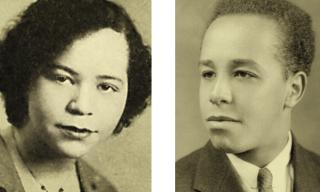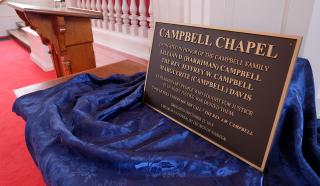Advertisement
On a hot September afternoon, Harry Purkhiser walks among the graves at Edgewood Cemetery in Nashua, New Hampshire, looking for plot J14R. It’s been about a year since he first went on this exact same errand.
The first time, “I spent maybe an hour thinking, ‘I must not be at the right plot,’ wandering around,” he says. This time, after about ten minutes, he finds it. The plot belongs to the Campbell family. It is well maintained, surrounded by other families’ headstones, with green leaves rustling above. Lovely though it is, for decades, J14R bore no marker; nothing hinted that two of the three Unitarian Universalists buried there—Lillian Campbell, the Rev. Jeffrey Campbell, and Marguerite Campbell Davis—became lightning rods for racism in the faith. It wasn’t until 2018 that that would change, thanks to the reparation efforts of the Unitarian Universalist Church of Nashua.

Siblings Marguerite Campbell Davis and the Rev. Jeffrey Campbell, in 1933 (courtesy UUCN; St. Lawrence University)
In 1919, the Campbell family, including 9-year-old Jeffrey and 3-year-old Marguerite, moved to Nashua from Boston. Lillian, who was white, had married Jeffrey Sr., an African-American lawyer, opening a rift in her family. In Boston, the Campbells were harassed, and their house was burned down in an apparent act of bigotry, says Jocelyn Lash, Jeffrey Campbell’s older daughter. Jeffrey Sr. “was killed in a racial incident involving an ax” when Jeffrey was 12, Lash recalls her father telling her and her sister.
By 1920, the Campbells had begun attending First Universalist Society of Nashua. Congregants accepted the family (Lillian later worked there as a secretary) with a keen awareness of the children’s skin color. In a 1940 essay in the Christian Leader, “Personality Not Pigmentation,” Jeffrey Campbell describes a congregation wrestling with his inclusion and a latent whites-only mentality at odds with the tenets of Universalism, most notably the universal brotherhood of man. Nevertheless, the family stayed.
Campbell graduated from St. Lawrence University’s theology school in 1935. The prospect of his ordination prompted the Rev. Harry Westbrook Reed of Watertown, New York, to write to the Rev. Roger Etz, secretary and general superintendent of the Universalist Convention: “[D]o you have any idea that any parish of any size would accept him? And is it not true that it would be almost impossible for him to minister to a colored church?”
In the spring of 2017, Unitarian Universalist Church of Nashua members Purkhiser, Roy Goodman, and Tristan Husby formed the church’s Jeffrey Campbell Study Group after Husby read about the Campbells in the book Darkening the Doorways, edited by the Rev. Dr. Mark Morrison-Reed, which devotes an entire chapter to Jeffrey and Marguerite. “Here’s a man, a leader from a Universalist church in Nashua . . . but when I brought him up at church meetings, all I got were blank stares,” says Husby. Around the same time, a cohort from the Nashua church heard Morrison-Reed speak. The Campbells emerged again in his lecture, and the Nashua trio decided to act.
They scoured material from their own archives, the local newspaper, Harvard Divinity School, and beyond for nearly a year. More letters from Universalist leaders revealed behind-the-scenes discrimination, but the real shock came in the pages of the Christian Leader, the Universalist denominational publication—the UU World of its day.
In 1939, when Marguerite married Francis Davis, a white Universalist minister-in-training, her brother officiated. The wedding prompted “Idealism and Realism in Mixed Marriages,” an editorial by the Christian Leader’s editor, John van Schaick. In the August 12 piece, van Shaick attacked mixed marriages, and—without naming him—the Rev. Jeffrey Campbell, for marrying the couple.
Campbell’s “Personality Not Pigmentation,” published in the Christian Leader in February of 1940, directly addressed van Shaick’s positions, but that wasn’t the end. “People responded,” says Morrison-Reed. “Imagine that you’re getting married, and the editor of UU World writes about you and your husband in the magazine.” Debate continued in the publication in the form of letters and editorials for years.
Marguerite Campbell Davis and her husband ultimately divorced. He left the ministry, and she took a job at the Universalist Christian Association, staying on past the 1961 Unitarian and Universalist consolidation until retiring from the Unitarian Universalist Association. When Lash, who didn’t know the details of her aunt’s early years, researched online, the racism shocked her. “It answered a lot of questions for me as to why she had always been so sad,” Lash says.
After his 1935 ordination, Campbell served as president of the International Religious Fellowship and ran for governor of Massachusetts as a socialist party candidate. He moved to England in 1939, and in 1951 moved to Vermont. There, he taught English literature at the Putney School until retiring in 1980. Campbell also served as part-time minister at the UU congregation in Amherst, Massachusetts, from 1967 until 1974, and as an unpaid minister on call at the UU church in Brattleboro, Vermont. In 1969, he delivered the sermon “A Road for Everyman” at the UUA General Assembly’s Service of the Living Tradition. Having dedicated his life to his faith’s values and teachings—having said in “Personality Not Pigmentation” that he would still undertake the call to Universalist ministry—he never served as settled minister of a congregation.
In 1962, Lillian Campbell died and was buried in Edgewood Cemetery plot J14R, as were Davis and the Rev. Campbell in 1983 and 1984, respectively. Years later, “The discovery of the unmarked grave was another way that it felt like their story was being erased,” says Nashua’s settled minister, the Rev. Allison Palm. The study committee’s research offered proof positive the Universalist and UU denominations—and even the Nashua congregation’s forebears—had struggled, torn between the brotherhood of man and their inherent racial bias. Goodman, a member of the Jeffrey Campbell Study Group, emphasizes that “it’s really not that long ago.”
Goodman created a Campbell display last winter, ahead of the study committee’s February service about the family. During that service, Palm announced a campaign through Faithify, the UU crowdfunding site, for a marker at Edgewood Cemetery honoring the Campbells, with the blessing of Lash and her sister, Allison Campbell. Response to the service was immediate, positive, and continued on Faithify: The overwhelmingly white congregation of 270 overshot its goal of $2,500, raising more than $4,000 in less than a week.
On September 22, 2018, a day to remember and reconcile with the family, Palm blessed the newly marked Campbell grave. About forty attendees laid flowers on the marker, a commitment to keep the family’s story alive. At the church, they, and others, heard from speakers, including Palm, study group members, and the local NAACP chapter. And 83 years after the Rev. Jeffrey Campbell’s ordination, UUA Executive Vice President Carey McDonald made a statement: “I want to offer, on behalf of the UUA, a humble apology to Jeffrey, Marguerite, Lillian, and Francis, and to their family . . .,” he said. “I can only imagine what would have been illuminated had the brilliant light of these ancestors been permitted to shine.” Last came a blessing for the building’s chapel, now officially named the Campbell Chapel.
It felt right, poignant, and complete, but Palm, Husby, Goodman, and Purkhiser say the work isn’t done. The group has taken its display and sermon to All Souls UU Church in Brattleboro, Vermont, and plans to visit other congregations. They want a wider audience to hear the story, in part to encourage other congregations to do similar work. “I suspect there are more stories like this out there,” Purkhiser explains. The Nashua congregation will probe more into its own history, including its connections with the city’s mills and slavery. “It’s part of this bigger project of thinking about on whose backs was this church built, and on whose unrecognized backs?” Palm says. “And how can we now . . . pay that back in some way?”
For Allison Campbell, the Nashua congregation’s dive into its history calls to mind family dynamics. “These are places where [UUs] didn’t do so well and you are pulling together around that,” she says. “I think it’s one of the more beautiful things that humans do, is we try to understand where things come from and why.”
Darkening the Doorways, ed. by Mark Morrison-Reed (Skinner House, 2011).
The Selma Awakening, by Mark Morrison-Reed (Skinner House, 2014). Includes curriculum to help congregations look through their archives.
Been in the Storm So Long, by Mark Morrison-Reed (Skinner House, 1991). Includes writings by the Rev. Jeffrey Campbell and Marguerite Campbell Davis.
